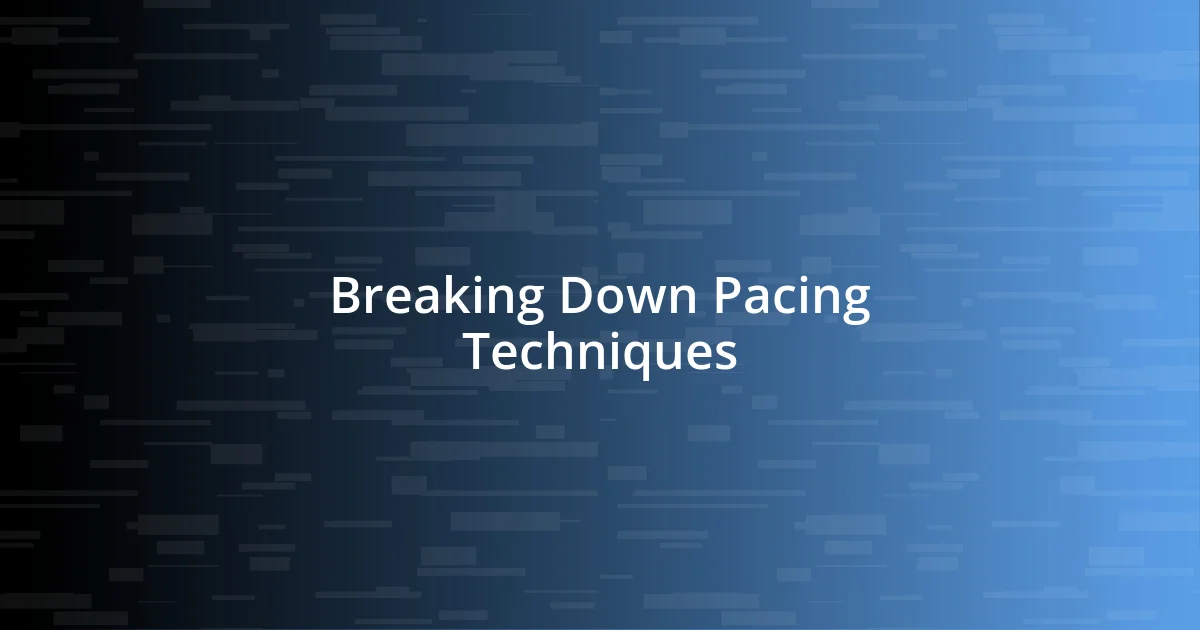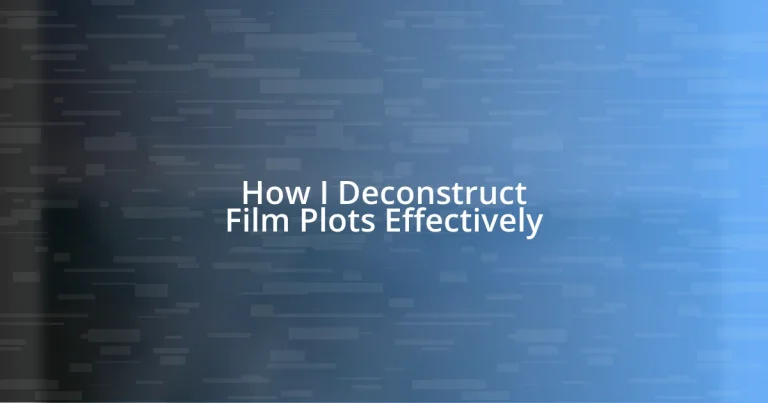Key takeaways:
- The classic three-act structure of setup, confrontation, and resolution is essential for effective storytelling in films.
- Character development, including motivations, relationships, and growth, plays a crucial role in enhancing viewer engagement and emotional investment.
- Exploring themes, motifs, and pacing techniques deepens the understanding of the narrative, encouraging personal reflection and richer film critique.

Understanding Film Narrative Structure
When I first started analyzing film plots, I found myself drawn to the structure of storytelling. It’s fascinating to see how films often rely on a classic three-act structure: setup, confrontation, and resolution. This framework helps filmmakers create tension and engage viewers, making us feel invested in the characters’ journeys.
What really struck me was the interplay of subplots within the main narrative. Think about how these side stories can deepen your emotional connection to the characters. For instance, I remember watching a film where a small subplot involving a sibling’s relationship added layers to the protagonist’s motivation, making the climax that much more poignant. Doesn’t it make you think about how every little detail serves a purpose in storytelling?
As I’ve deconstructed various films over the years, I’ve noticed that the climax often acts as a turning point that redefines the character’s trajectory. It’s that moment when everything hangs in the balance! How thrilling is it to watch characters confront their biggest challenges? This realization has changed how I view each film, enhancing my appreciation of the intricate design behind every narrative decision.

Identifying Plot Elements
Identifying plot elements is a critical step in film analysis. I find that acknowledging character motivations can often reveal why certain events unfold as they do. For example, I once watched a thriller where the protagonist’s desperate desire to protect their family drove the story in unexpected directions. This not only kept me on the edge of my seat but also made me reflect on how our personal motivations can heavily influence decisions in our own lives.
Moreover, understanding the setting’s role in shaping the plot can be eye-opening. During a film set in a dystopian world, I realized that the bleakness of the environment heightened my emotional response to the character’s struggles. The choice of setting can represent barriers or opportunities, making it essential to analyze how it interacts with other plot elements. Can you think of a film where the location became a character itself?
When discussing conflict, it’s important to differentiate between internal and external challenges faced by characters. I remember watching a drama where the lead’s internal struggle with guilt was just as compelling as the external threats from antagonist characters. This duality creates a rich narrative tapestry that resonates with viewers, inviting them to reflect on their own conflicts. Recognizing these elements transforms watching into a more profound experience.
| Plot Element | Significance |
|---|---|
| Character Motivations | Drives the narrative, influences actions |
| Setting | Shapes emotional tone, represents barriers/opportunities |
| Conflict | Engages viewers through internal and external challenges |

Analyzing Character Development
When I delve into character development, I’m always intrigued by how a well-crafted arc can evoke deep emotional responses from viewers. I recall watching a coming-of-age film where the protagonist transitioned from an insecure teenager to a confident young adult. This process resonated with me because it mirrored my own experiences of personal growth. There’s something powerful about seeing characters evolve, and it emphasizes how struggles and triumphs are universal.
To effectively analyze character development, I consider several key aspects:
- Backstory: Understanding a character’s past can shed light on their current actions and decisions.
- Motivation: What drives the character? This revelation can turn an ordinary story into a compelling narrative.
- Relationships: The dynamics with other characters often reveal significant changes, showcasing vulnerability or strength.
- Growth: Watching how characters confront obstacles and succeed or fail provides insight into the human condition.
Each of these elements serves to draw viewers into a character’s journey, enhancing our emotional investment.

Exploring Themes and Motifs
Exploring themes and motifs in film allows me to connect on a deeper level with the narrative. For instance, I once watched a film that centered around the theme of redemption. As the protagonist embarked on a journey to atone for past mistakes, I couldn’t help but reflect on moments in my own life where I sought forgiveness. Don’t you find that such themes resonate personally, making the experience more impactful?
Motifs, on the other hand, serve as subtle reminders of these overarching themes. In a particular mystery film I enjoyed, a recurring motif of shattered mirrors symbolized fractured identities. Each time I spotted a broken mirror, it heightened my understanding of the character’s psychological state. It’s fascinating how these visual elements can deepen the story’s emotional weight. Have you noticed any motifs that lingered in your mind long after the credits rolled?
When I analyze themes, I often think about how they reflect societal issues. For example, in a dystopian flick I recently viewed, the struggle against oppressive systems was not just a plot element; it mirrored real-world challenges we face today. This connection sparked a discussion among friends about the relevance of film in our lives. By exploring these themes and motifs, we can transcend mere entertainment and engage in meaningful conversations. What themes have sparked debates among your circle?

Breaking Down Pacing Techniques
Breaking Down Pacing Techniques
When I analyze pacing techniques in film, I often pay close attention to how the rhythm of scenes can either heighten tension or provide relief. There was a thriller I recently watched that expertly manipulated pacing; the rapid cuts during action sequences had my heart racing, while the slower, lingering shots allowed the suspense to build, pulling me deeper into the story. Isn’t it intriguing how a shift in pacing can influence our emotional responses so dramatically?
I find that pacing is not just about speed; it’s about timing and placement within the narrative. For instance, in a romantic drama, I noticed how the filmmakers used slower pacing during intimate moments, allowing viewers to feel every flicker of emotion, every glance, as if we were experiencing those feelings ourselves. I’ve often thought about how this mirrors the pauses in real-life relationships—those moments that seem to stretch on, filled with unspoken words. Have you ever reflected on how a film’s pacing mirrors your own experiences with relationships or pivotal moments in your life?
Moreover, I pay attention to how filmmakers use pacing to guide the audience’s focus. In a recent sci-fi film, I observed the deliberate slow burn leading up to a plot twist that completely changed everything. It struck me—good pacing can transform how we perceive a story, as it creates anticipation and engagement. From my perspective, understanding these techniques not only enriches our viewing experience but empowers us to craft better narratives ourselves. What pacing choices have you noticed that altered your perception of a film’s climax?

Techniques for Plot Deconstruction
When I deconstruct film plots, focusing on character development becomes essential. There was one film where the protagonist started as a selfish individual but evolved into a selfless hero by the end. It struck me how this transformation wasn’t just a plot device—it echoed the growth I sometimes aspire to in my own life. Have you ever seen a character whose journey resonated so deeply that it made you reflect on your own path?
Another technique I utilize is analyzing the story structure. Remember that indie film with the non-linear narrative? I found it refreshing how the shifts in time added layers of complexity to the storyline. Each flashback not only revealed character motivations but also enriched the emotional stakes. I often wonder how different the experience would have been with a traditional, linear approach. Have you experienced a non-linear plot that left you questioning the impact of its structure?
I also look for symbolic elements that elevate the narrative. In a recent fantasy film, the recurring image of a fading star reflected the theme of lost potential. Each time I saw that star flicker, it reminded me of moments in my life when I felt I was drifting away from my own goals. Isn’t it fascinating how such symbols can awaken personal reflections and add layers to our interpretation? What symbols in films have made you ponder your own dreams and ambitions?

Applying Insights to Film Critique
When I dive into film critique, I always find that context plays a crucial role in shaping my perspective. Take, for instance, a foreign film I watched that explored themes of isolation amidst an urban backdrop. The stark contrast between the character’s internal struggle and the bustling city life around them struck a chord with me. Have you ever considered how a film’s setting can reflect the emotional landscape of its characters?
In my experience, examining a film’s motifs can bring new layers of understanding. Recently, I analyzed a drama that intertwined memories of childhood innocence with darker adult realities. Each flashback felt like a breadcrumb leading to the protagonist’s ultimate revelation, which resonated deeply with my reflections on growing up. I often ask myself: how do these motifs mirror my own life experiences, and can their portrayal open up conversations about our own pasts?
Additionally, I think it’s essential to consider the director’s intent when critiquing a film. The artistic choices made—from camera angles to music selection—can usher us into the filmmaker’s vision. I recall a documentary that used an intimate first-person narration style, allowing me to feel so connected to the subject that it changed my understanding of real-life struggles. It makes me wonder, how often do we overlook the director’s perspective, and how does this shape our engagement with the story?














